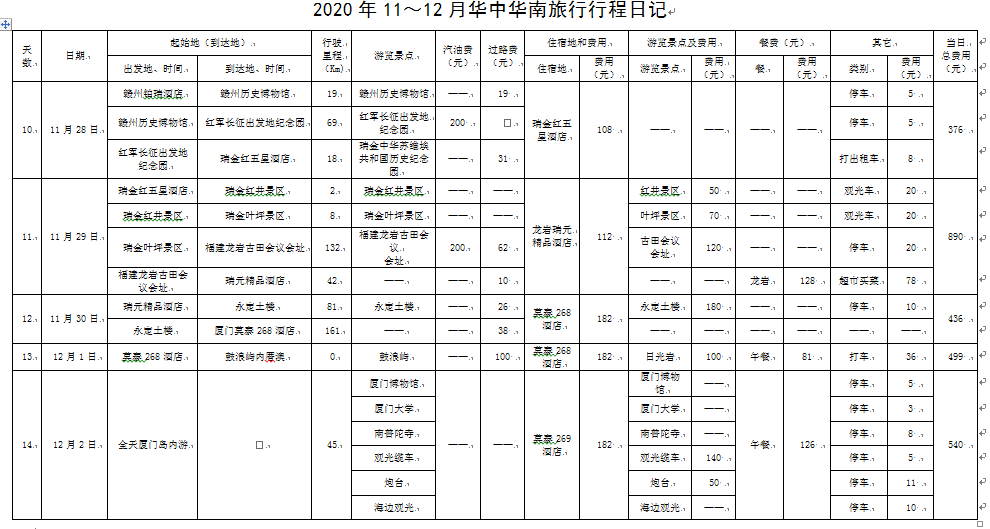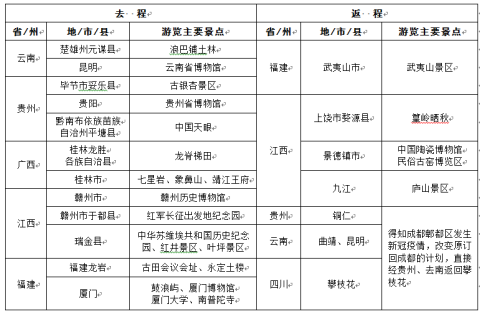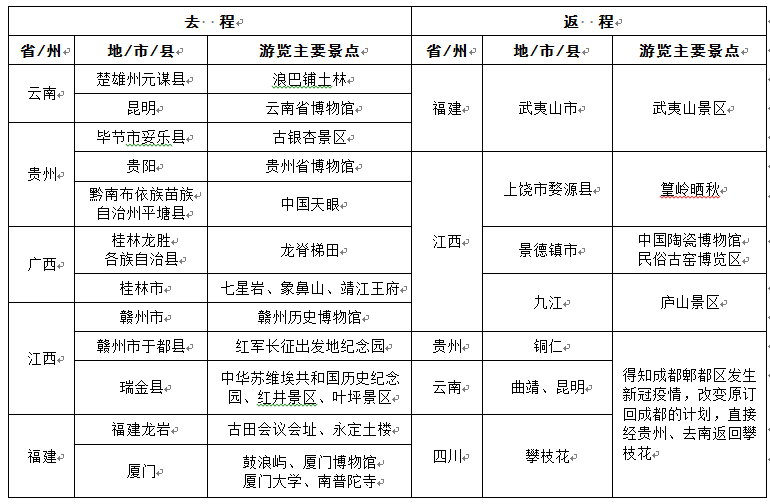From November 19th to December 10th, 2020, my husband and I completed our long-awaited trip to South China in 22 days. This time it was a purely self-driving tour for just the two of us, passing through more than ten cities in six provinces including Yunnan, Guizhou, Guangxi, Jiangxi, Fujian, and Hunan. We visited the Yuanmou Langbapu Earth Forest in Chuxiong, Yunnan, the "China Sky Eye" in Guizhou, Longsheng Longji Rice Terraces in Guangxi, the birthplace of the Chinese Soviet in Ganzhou, Jiangxi, the starting point of the Red Army's Long March in Yudu, the Gutian Conference Site in Longyan, Fujian, and the Yongding Earth Building in Fujian. Gulangyu Island in Xiamen, Wuyishan in Fujian, Jingdezhen in Jiangxi, Huangling in Wuyuan in Shangrao in Jiangxi, Lushan Scenic Area in Jiangxi, and several provincial museums.
The trip lasted 22 days, covering a total distance of 5,961 kilometers, with a total consumption of 13,053 yuan. Among them, gasoline is 3064 yuan, accounting for 23.47% of the total cost, and the fuel cost per 100 kilometers is 51.40 yuan; toll fee is 2984 yuan, accounting for 22.86% of the total cost; accommodation fee is 2812 yuan, accounting for 21.54% of the total cost; Attraction tickets and sightseeing cars are 2,442 yuan, accounting for 18.71% of the total cost; Meals are 801 yuan (excluding the cost of bringing your own food), accounting for 6.14% of the total cost; Others are 950 yuan, accounting for 7.28 of the total cost %. For detailed travel routes, accommodations, and tourist attraction records, please refer to the appendix "Central China and South China Travel Itinerary Diary from November to December 2020".1. Main attractions to visit
According to the classification of natural landscape, modern high technology, historical and cultural heritage, and red scenic spots, the main attractions (areas) of this tour are:
Natural landscapes: Langbapu Earth Forest in Yunnan Yunnan, Longsheng Longji Rice Terraces in Guilin, Guilin landscape, Gulangyu Island in Xiamen, Wuyi Mountain in Fujian, Lushan Mountain in Jiangxi;
Modern high-tech: "China Sky Eye" in Pingtang, Guizhou;
Historical and cultural heritage: China Ceramics Museum in Jingdezhen, Jiangxi, Yongding Earth Buildings in Longyan, Fujian, Huangling, Wuyuan, Shangrao, Jiangxi, etc.;
Red attractions: the birthplace of the Chinese Soviet Union in Ganzhou, Jiangxi Province, Hongjing Scenic Area and Yeping Scenic Area in Ganzhou, Jiangxi Province, the starting point of the Long March of the Red Army in Yudu, the Historical Memorial Park of the Chinese Soviet Republic in Ruijin, the Gutian Conference Site in Fujian, etc.
We also visited Yunnan Provincial Museum, Guizhou Provincial Museum, Ganzhou History Museum, Xiamen Museum, China Ceramics Museum, Jingdezhen Ancient Folk Kiln Expo Area, etc.
For details, please see the table of "South China Travel Attractions from November to December 2020"
This travel note will serve as the prelude to this series of travel notes, outlining the overall overview of the trip. Next, more than ten special travel notes will be formed to introduce in detail the natural and cultural landscapes, background stories, etc. of the places visited, as well as what they saw and thought. and what you think.2. Preparation before departure1. Read the Fujian special issue of "China National Geographic"When traveling to South China, be sure to understand the history and culture of Fujian Province and neighboring Zhejiang Province as a pre-trip knowledge reserve. In October before departure, I spent half a month reading the special issue of "China National Geographic" introducing Fujian Province. Issues 4 and 5 of 2009 are special issues on Fujian. The preface of the special issue is written by teacher Shan Zhiqiang from the editorial department. It contains rich knowledge points and unique perspectives. With the preparation of reading preview, this trip took the historical background and humanistic environment described in the article to visit some of the scenic spots described in the article;These four articles are: "The Wish of a Chinese Pirate" in the preface of the 4th issue in 2009; "Contradictory Fujian" in the preface of the 5th issue in 2009. I have recorded the two articles into word documents. In the following travel notes, I will excerpt and quote parts of the two articles at appropriate times, and talk about my own understanding and feelings;2. Tableware, food and long-distance travel equipmentTableware: ⑴ High-power rechargeable power supply, used for steamers and rice cookers on the road, ensuring that you can enjoy delicious and hot food at any time along the way; ⑵ Travel set tableware such as travel refrigerators, electric ceramic stoves, electric pressure cookers, frying pans, etc.; ⑶Plastic portable storage box for condiments;Food: Home-made steamed and frozen dumplings, pies, red bean paste buns, Wuren buns, sugar cakes, steamed buns and other pasta; 20 packs of instant noodles (it is recommended to buy spicy ramen without condiments online), dry rice noodles, dried noodles, salted duck eggs, Bacon, fried mustard, fried meat with soybean paste, vegetables, etc. (semi-finished foods can be replenished at the local supermarket at any time);Clothing: Clothes and sun protection items that are suitable for the climate where you are traveling; try to choose casual clothes and travel shoes; choose some organizing bags, trolley cases, and trolleys that are convenient for storing and carrying clothes;Medicines: cold, anti-inflammatory, diarrhea, trauma first aid and other medicines;Tools for temporary vehicle troubleshooting: traction ropes, tire replacement kits, etc.;3. Preparation for regular long-distance travel1. Traveling long distances to visit the great rivers and mountains of the motherland, and reading about the five thousand years of history and culture left by our ancestors is the biggest job for my husband and me at the moment, and it will be our main way of life in the future. We plan to arrange 2 to 3 long-distance self-driving trips every year. Make travel plans, read relevant information, and prepare travel clothing and food one month in advance before each trip. After the trip is completed, use 1 to 2 months to sort out the travel photos and review the travel experience, review relevant information, digest and understand the unanswered questions and questions encountered during the trip, organize the travel notes and edit them into a WeChat version to share with friends;2. Maintain your car and purchase travel insurance before traveling. Be proficient in using mobile travel APPs, such as navigation, traffic information inquiry, real-time traffic tracking, hotel inquiry, weather condition inquiry, etc.;3. Avoid traveling during holidays and winter and summer vacations. At this time, hotel accommodation is affordable, there are few cars on the road, and the scenic spots are less crowded. In terms of travel direction, try to arrange travel to the north or the Central Plains after spring, and arrange travel to the south during autumn and winter. During the trip, we observed and learned about resort-style hotels that are suitable for our middle-aged and elderly people to travel, live and relax, so that they can stay for short-term travel in suitable seasons in the future;4. Visiting the museum is a great value for moneyMuseums in various places bring together the essence of local Chinese culture, with a huge amount of knowledge, a good visiting environment, and an elegant and solemn visual experience. Free admission to museums is a benefit measure for the country to improve the quality of the people. We can enjoy the great benefits provided by the government. Some regional special museums are chargeable and can be visited optionally.Visiting a museum is strenuous work, takes a long time, and is quite strenuous on foot. It is recommended to check relevant information online before visiting to learn about the key cultural relics in the exhibition hall. Try to arrange your visit in the morning, and be in good physical and mental condition. Take a 15-20 minute break after visiting each topic in the museum for about 40 minutes, and then arrange to visit the next exhibition area to avoid excessive fatigue.Please note that the museum is open six days a week (excluding holidays) and is normally closed every Monday.Attached table: Central and Southern China travel itinerary diary from November to December 2020







